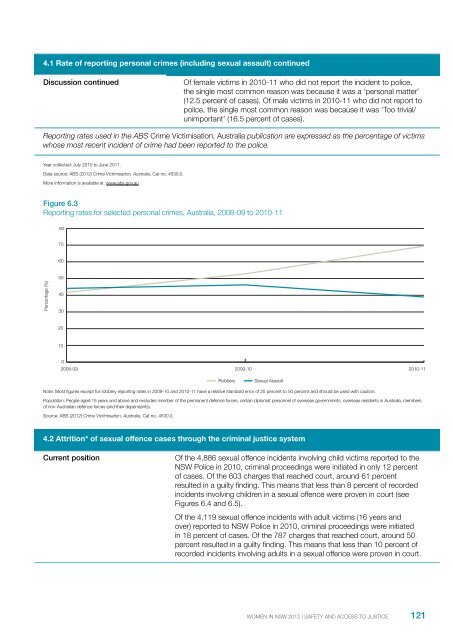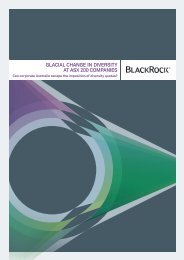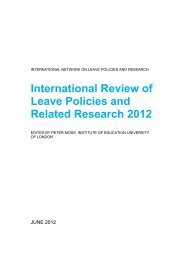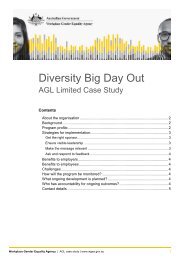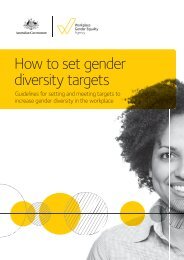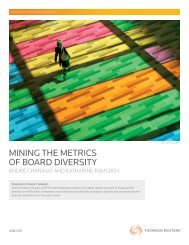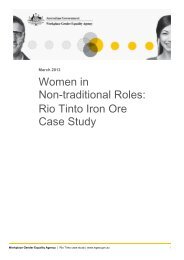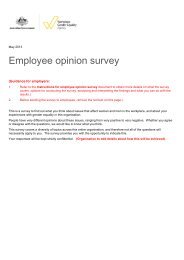Topic 4:<strong>The</strong> justice systemThis topic covers report<strong>in</strong>g rates,attrition of cases through thejustice system, court-grantedApprehended Domestic ViolenceOrders (ADVOs) and penalties.As noted earlier, a significantproportion of domestic violenceand sexual assault <strong>in</strong>cidents arenever reported to police and cannottherefore progress through thecrim<strong>in</strong>al justice system. Indicator4.1 provides comparative dataon estimated report<strong>in</strong>g rates fora crime where the majority ofvictims are female (sexual assault)and a crime where the majorityof victims are male (robbery).Once police record an <strong>in</strong>cident,they must <strong>in</strong>vestigate and decidewhether to lay crim<strong>in</strong>al chargesaga<strong>in</strong>st a suspect (the allegedoffender). If charges are laid, theywill be heard <strong>in</strong> court and the courtwill decide whether the charges areproved beyond reasonable doubt. Ifthe crim<strong>in</strong>al charges are proved, thecourt will sentence the offender.Most sexual offences that arereported to police proceed nofurther than the <strong>in</strong>vestigation stage,and the number of sexual offencesrecorded by police is far greaterthan the number of charges proven<strong>in</strong> court. Indicator 4.2 reports onattrition of sexual offence casesdur<strong>in</strong>g police <strong>in</strong>vestigation andwith<strong>in</strong> the justice system.Indicator 4.3 reports on ADVOsgranted by courts <strong>in</strong> <strong>NSW</strong> over timeand by geographic spread.4.1 Rate of report<strong>in</strong>g personal crimes (<strong>in</strong>clud<strong>in</strong>g sexual assault)Current position<strong>The</strong> direction of changeover timeDiscussionReport<strong>in</strong>g rates for common personal crimes <strong>in</strong> <strong>NSW</strong> are lower for a crimewhere women are the majority of victims (sexual assault) than for crimeswhere men are the majority of victims (physical assault and robbery).<strong>Gender</strong> gaps:• 39 percent for sexual assault (where the majority of victims are female,see Indicator 1.2).• 55 percent for physical assault (where the majority of victims are male,see Indicator 2.1).• 69 percent for robbery (where the majority of victims are male: 46,900male victims nationally <strong>in</strong> 2010-11 compared to 30,400 female victims).As <strong>in</strong>dicated <strong>in</strong> Figure 6.3, the report<strong>in</strong>g rate for robbery has <strong>in</strong>creased overthe last three years, while the report<strong>in</strong>g rate for sexual assaults has rema<strong>in</strong>edrelatively stable (bear<strong>in</strong>g <strong>in</strong> m<strong>in</strong>d that these figures are estimates).Research cited by the <strong>NSW</strong> Bureau of Crime Statistics and Research <strong>in</strong>2006 suggested that adult women are more likely to report sexual assaultvictimisation if they susta<strong>in</strong> a physical <strong>in</strong>jury, if they are born overseas or if theperpetrator is a stranger 33 . <strong>The</strong> research also suggests that report<strong>in</strong>g is not<strong>in</strong>fluenced by age, education, labour force status, marital status, source of<strong>in</strong>come, childhood abuse or prior adult violence.<strong>The</strong> ABS Crime Victimisation, Australia, 2010-11 survey found that, acrossAustralia, female victims <strong>in</strong> 2010-11 were more likely than male victims toreport their most recent <strong>in</strong>cident of physical assault to police (55.1 percentcompared to 47.6 percent).33 Fitzgerald J (2006) <strong>The</strong> attrition of sexual offences from the New South Wales crim<strong>in</strong>al justice system, <strong>NSW</strong> Bureau of Crime Statistics and Research, Crime and Justice Bullet<strong>in</strong> no.92.120 WOMEN IN <strong>NSW</strong> <strong>2012</strong> | SAFETY AND ACCESS TO JUSTICE
4.1 Rate of report<strong>in</strong>g personal crimes (<strong>in</strong>clud<strong>in</strong>g sexual assault) cont<strong>in</strong>uedDiscussion cont<strong>in</strong>uedOf female victims <strong>in</strong> 2010-11 who did not report the <strong>in</strong>cident to police,the s<strong>in</strong>gle most common reason was because it was a ‘personal matter’(12.5 percent of cases). Of male victims <strong>in</strong> 2010-11 who did not report topolice, the s<strong>in</strong>gle most common reason was because it was ‘Too trivial/unimportant’ (16.5 percent of cases).Report<strong>in</strong>g rates used <strong>in</strong> the ABS Crime Victimisation, Australia publication are expressed as the percentage of victimswhose most recent <strong>in</strong>cident of crime had been reported to the police.Year collected: July 2010 to June 2011.Data source: ABS (<strong>2012</strong>) Crime Victimisation, Australia, Cat no. 4530.0.More <strong>in</strong>formation is available at: www.abs.gov.auFigure 6.3Report<strong>in</strong>g rates for selected personal crimes, Australia, 2008-09 to 2010-1180706050Percentage (%)4030201002008-092009-102010-11RobberySexual AssaultNote: Most figures except for robbery report<strong>in</strong>g rates <strong>in</strong> 2009-10 and 2010-11 have a relative standard error of 25 percent to 50 percent and should be used with caution.Population: People aged 15 years and above and excludes member of the permanent defence forces, certa<strong>in</strong> diplomat personnel of overseas governments, overseas residents <strong>in</strong> Australia, membersof non-Australian defence forces (and their dependants).Source: ABS (<strong>2012</strong>) Crime Victimisation, Australia, Cat no. 4530.0.4.2 Attrition* of sexual offence cases through the crim<strong>in</strong>al justice systemCurrent positionOf the 4,886 sexual offence <strong>in</strong>cidents <strong>in</strong>volv<strong>in</strong>g child victims reported to the<strong>NSW</strong> Police <strong>in</strong> 2010, crim<strong>in</strong>al proceed<strong>in</strong>gs were <strong>in</strong>itiated <strong>in</strong> only 12 percentof cases. Of the 603 charges that reached court, around 61 percentresulted <strong>in</strong> a guilty f<strong>in</strong>d<strong>in</strong>g. This means that less than 8 percent of recorded<strong>in</strong>cidents <strong>in</strong>volv<strong>in</strong>g children <strong>in</strong> a sexual offence were proven <strong>in</strong> court (seeFigures 6.4 and 6.5).Of the 4,119 sexual offence <strong>in</strong>cidents with adult victims (16 years andover) reported to <strong>NSW</strong> Police <strong>in</strong> 2010, crim<strong>in</strong>al proceed<strong>in</strong>gs were <strong>in</strong>itiated<strong>in</strong> 18 percent of cases. Of the 787 charges that reached court, around 50percent resulted <strong>in</strong> a guilty f<strong>in</strong>d<strong>in</strong>g. This means that less than 10 percent ofrecorded <strong>in</strong>cidents <strong>in</strong>volv<strong>in</strong>g adults <strong>in</strong> a sexual offence were proven <strong>in</strong> court.WOMEN IN <strong>NSW</strong> <strong>2012</strong> | SAFETY AND ACCESS TO JUSTICE121


